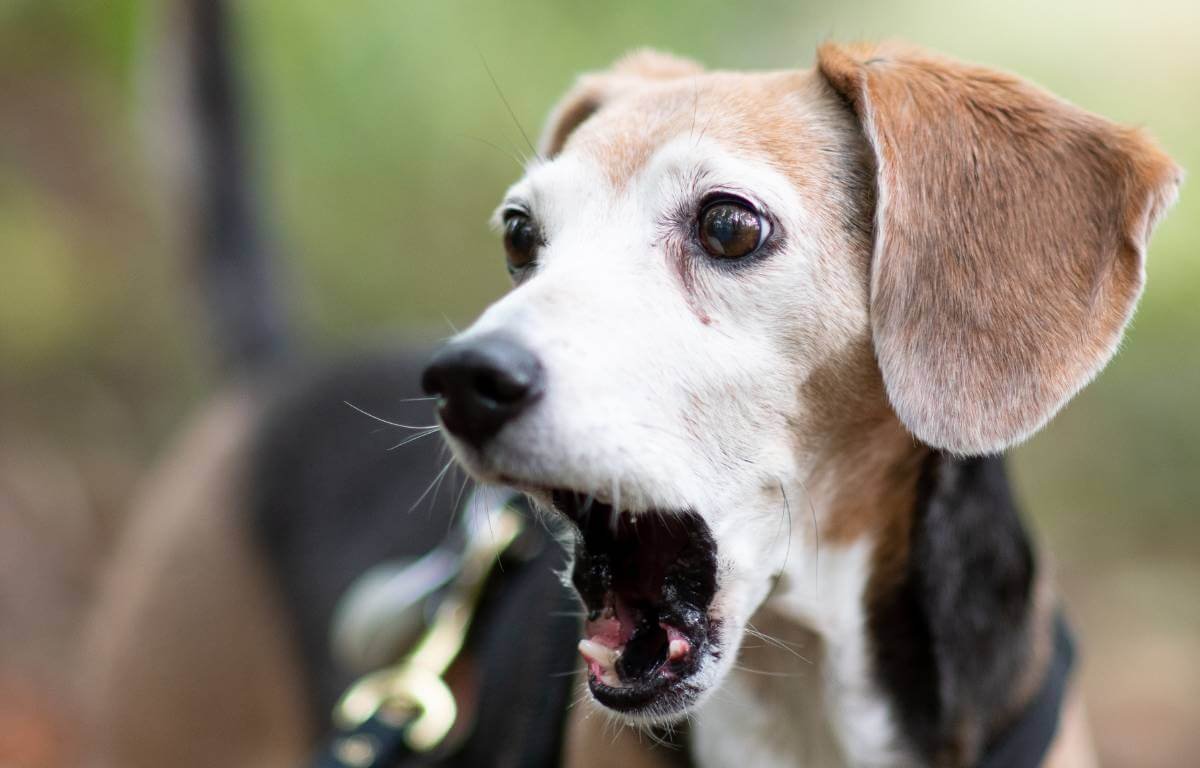As a dog owner, dealing with an angry beagle can be a challenging and stressful experience. Beagles are generally known for their friendly and affectionate nature, but like any other breed, they can display aggressive behavior. Understanding what triggers their aggression and how to train them can help you manage your dog’s behavior and prevent any potential harm.
Beagles are known for their high energy levels, curiosity, and strong sense of smell. They are also pack animals, which means they have a natural instinct to establish a hierarchy and assert dominance. When they feel threatened or challenged, they may become aggressive towards humans or other animals. Identifying the signs of aggression and understanding the underlying causes can help you address the behavior early on and prevent it from escalating.
In this article, I will explore the various factors that contribute to an angry beagle’s behavior. I will discuss common triggers for aggression, health problems that may cause aggression, and effective training methods to curb aggressive behavior. Whether you are a first-time beagle owner or have had experience with the breed, this article will provide valuable insights into managing an angry beagle and promoting a safe and healthy environment for your furry friend.
Key Takeaways
- Understanding the underlying causes of beagle aggression is crucial for preventing and managing the behavior.
- Common triggers for aggression include fear, territorial behavior, and resource guarding.
- Effective training methods and seeking professional help can help manage an angry beagle’s behavior.
Understanding Beagle Temperament

As a beagle owner, I have come to learn a lot about the breed’s temperament. Beagles are known for their friendly and energetic nature, which makes them great family pets. However, they were originally bred as hunting dogs, which means they have a strong prey drive and can be prone to chasing after small animals.
One of the most important things to understand about beagles is that they are pack animals. This means that they thrive in a social environment and can become anxious or even aggressive if left alone for long periods of time. It’s important to provide your beagle with plenty of socialization and exercise to keep them happy and healthy.
Beagles are also known for their stubbornness. They have a strong will and can be difficult to train if you don’t establish yourself as the pack leader. However, with patience and consistency, beagles can be trained to obey commands and behave appropriately.
Another important aspect of beagle temperament is their vocalization. Beagles are known for their loud and distinctive bark, which they use to communicate with their pack. This can be a problem if you live in an apartment or have close neighbors, so it’s important to train your beagle to bark only when necessary.
In summary, beagles are energetic, friendly, and social dogs that require plenty of exercise and socialization. They can be stubborn and vocal, but with proper training and leadership, they make great family pets. As with any breed, it’s important to understand and respect their natural instincts and behaviors to ensure a happy and healthy relationship.
Identifying Aggressive Behavior
As a beagle owner, it’s important to know how to identify aggressive behavior in your pet. While beagles are generally friendly and mild-tempered, like any other breed, they can exhibit hostile behavior when triggered or threatened.
Growling and Biting
Growling and biting are clear signs of angry beagle. If your pet growls at you or other people, it’s a warning sign that they are feeling threatened or uncomfortable. Similarly, biting is a serious form of aggression and should not be taken lightly.
It’s important to note that growling and biting are not always unprovoked. Beagles may bite in self-defense if they feel threatened or cornered. Additionally, they may growl or snap if they are in pain or feel unwell.
Nipping and Chasing
Nipping and chasing are also forms of aggressive behavior in beagles. While these behaviors may seem playful, they can quickly escalate into dangerous situations if not addressed.
Nipping is when a angry beagle uses its teeth to grab at a person or object. This behavior may be a sign of over-excitement or a lack of training. Chasing, on the other hand, is when a beagle runs after a person or animal. This behavior may be a sign of prey drive, but it can also be a form of aggression if the beagle is trying to attack.
If you notice your beagle exhibiting any of these aggressive behaviors, it’s important to address the issue immediately. Consult with a professional dog trainer or behaviorist to determine the root cause of the behavior and develop a plan to correct it.
Remember, aggressive behavior in beagles can be dangerous and should not be ignored. It’s important to take the necessary steps to ensure the safety of both your pet and those around them.
Common Triggers for Aggression

As a dog owner, it’s important to understand the common triggers that can cause aggression in your beagle. Here are some of the most common triggers:
Fear
Fear is one of the most common triggers for aggression in beagles. If your beagle feels threatened or scared, they may lash out in an attempt to protect themselves. This can happen in a variety of situations, such as meeting new people or animals, encountering loud noises, or being in unfamiliar environments. It’s important to socialize your beagle from a young age to help them feel more comfortable in these situations.
Pain
If your beagle is experiencing pain, they may become more aggressive than usual. This can happen if they have an injury or if they’re suffering from a medical condition. If you notice your beagle becoming more aggressive than usual, it’s important to take them to the vet to rule out any underlying medical issues.
Threats
Beagles are naturally protective of their owners and their territory. If they perceive a threat, they may become aggressive in an attempt to protect themselves and their family. This can happen if they encounter a stranger or if they feel that their territory is being invaded. It’s important to train your beagle to understand what is and isn’t a threat to help prevent aggression.
Triggers
Beagles can also become aggressive if they’re triggered by a certain stimulus. This can happen if they have a negative association with something, such as a specific person or object. If you notice your beagle becoming aggressive in certain situations, try to identify the trigger and work to desensitize them to it.
By understanding these common triggers for aggression in beagles, you can help prevent aggressive behavior and keep your beagle happy and healthy.
Health Problems and Aggression
As a beagle owner, I know that they are generally mild-tempered dogs. However, there are certain health problems that can cause your dog to be angry beagle. In this section, I will discuss some common health problems that can lead to aggression.
Swelling and Tender Spots
One of the most common health problems in beagles is swelling and tender spots. This can be caused by a variety of factors, including allergies, insect bites, and infections. If your beagle is experiencing swelling or tenderness, it can cause them to become irritable and aggressive.
To prevent swelling and tender spots, make sure your beagle is up-to-date on all their vaccinations and flea and tick prevention. Additionally, keep an eye on your beagle’s diet, as certain foods can cause allergic reactions.
If you notice swelling or tenderness, take your beagle to the vet immediately. Your vet can prescribe medication to help reduce the swelling and alleviate any pain your beagle may be experiencing.
In conclusion, beagles are generally mild-tempered dogs, but certain health problems can cause aggression. Swelling and tender spots are one of the most common health problems that can lead to aggression, so it’s important to take preventative measures and seek medical attention if you notice any symptoms.
Training an Angry Beagle
If you have an angry Beagle, it’s important to train them to prevent any aggressive behavior. In this section, I will discuss the two main approaches to training an angry Beagle: basic commands and behavior modification.
Basic Commands
Training your Beagle with basic commands is a great way to establish a clear line of communication between you and your dog. It can also help to prevent any unwanted behavior, including aggression. Here are some basic commands that every Beagle should know:
| Command | Description |
|---|---|
| Sit | Teach your Beagle to sit on command by holding a treat above their head and saying “sit.” |
| Stay | Once your Beagle has learned to sit, you can teach them to stay by saying “stay” and rewarding them for remaining seated. |
| Come | Teach your Beagle to come to you when called by saying “come” and rewarding them with a treat or praise when they do. |
| Leave it | Use this command to prevent your Beagle from picking up or eating something they shouldn’t. Say “leave it” and reward them for ignoring the object. |
By teaching your Beagle these basic commands, you can establish yourself as the pack leader and prevent any aggressive behavior.
Behavior Modification
If your Beagle is already displaying aggressive behavior, you may need to use behavior modification techniques to correct their behavior. Here are some tips for modifying your Beagle’s behavior:
- Redirect their attention: If your Beagle is displaying aggressive behavior towards a certain object or person, try redirecting their attention to something else. For example, if they are growling at another dog, try distracting them with a toy or treat.
- Use positive reinforcement: When your Beagle displays good behavior, be sure to reward them with treats or praise. This will encourage them to continue the good behavior.
- Seek professional help: If your Beagle’s aggressive behavior is severe or you are having trouble modifying their behavior on your own, consider seeking the help of a professional dog trainer or behaviorist.
By using these behavior modification techniques, you can help your Beagle overcome their aggressive behavior and become a well-behaved member of your family.
Professional Help
If your beagle’s aggressive behavior is becoming a serious issue, it may be time to seek professional help. There are two main types of professionals who can assist with aggressive behavior in dogs: veterinarians and dog trainers.
Veterinarian
A veterinarian should be the first person you turn to when your beagle is showing aggressive behavior. They can rule out any medical issues that may be causing the behavior, such as pain or illness. Additionally, they can provide medication to help manage the behavior, if necessary.
During your visit to the veterinarian, be prepared to discuss your angry beagle’s behavior in detail. The veterinarian may also ask you to fill out a questionnaire to better understand the behavior. After the assessment, the veterinarian may recommend a behavior modification plan or refer you to a dog trainer.
Dog Trainer
A dog trainer can help you address your beagle’s aggressive behavior through positive reinforcement training. They can teach you how to manage your angry beagle’s behavior and provide guidance on how to prevent future aggressive behavior.
When choosing a dog trainer, look for someone who has experience working with aggressive dogs and uses positive reinforcement techniques. A good trainer will work with you and your beagle to develop a customized behavior modification plan that fits your specific needs and goals.
It’s important to note that not all aggressive behavior can be resolved through training alone. In some cases, medication may be necessary to help manage the behavior. Your veterinarian and dog trainer can work together to determine the best course of action for your beagle.
Remember, aggression in beagles can be a serious issue and should not be ignored. Seeking professional help is the best way to address the behavior and ensure the safety of both your beagle and those around them.
Common FAQ
Why do beagles bite so much?
Playful nipping occurs during your Beagle’s early stages, typically when they are with their littermates. This behavior is part of their exploratory phase and serves as a vital lesson in Beagle etiquette. During this time, they grasp the concept that if a bite is too forceful or painful, their fellow pups will respond with a loud yelp.

Are Beagles moody?
Beagles thrive on human companionship and are naturally social animals accustomed to living within a group or pack. For the majority of Beagles, having someone with them during the day is essential. Being left alone for extended periods can lead to changes in their mood and may result in increased vocalization and restlessness.
Why does my beagle growl at me?
Dogs employ warning growls as a means of signaling to you or another animal to “stay away” due to their uneasiness. When their body language is rigid, ears pinned back, delivering a stern gaze, or freezing in place, it signifies a warning growl, a situation to be taken seriously.
Conclusion
In conclusion, it is important to understand that angry Beagles is not a common trait. Most Beagles are friendly, curious, and enjoy being around people. However, like any other breed, they can become aggressive under certain circumstances. It is important to provide them with the right kind of training and socialization from a young age to avoid any behavior problems.
As a Beagle owner, it is important to establish yourself as the pack leader and provide your dog with the right kind of structure and discipline. This includes setting rules and boundaries, providing plenty of exercise and mental stimulation, and rewarding good behavior.
It is also important to show your Beagle love and affection. Beagles are social animals and thrive on human interaction. Spending time with your Beagle, playing with them, and giving them plenty of attention can help prevent any feelings of loneliness or abandonment that can lead to aggressive behavior.
If you do notice any signs of aggression in your Beagle, it is important to seek professional help. A qualified dog trainer or behaviorist can help you identify the underlying cause of the behavior and provide you with the right kind of training and techniques to help control it.
In the end, a well-trained and well-socialized Beagle can make a great companion and family pet. With the right kind of love, attention, and training, you can help your Beagle become a happy, well-behaved member of your family.

